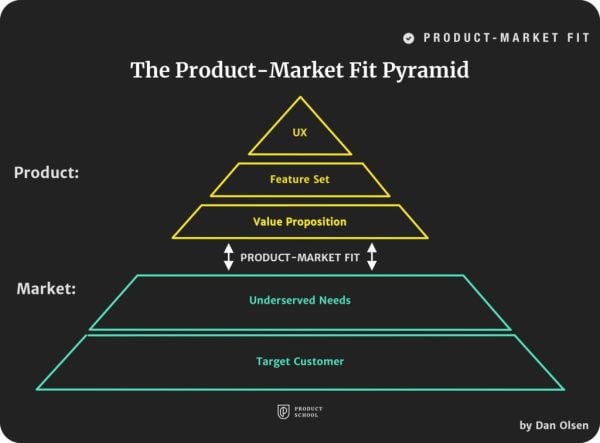Updated: January 24, 2024- 8 min read
A lot of information and knowledge comes your way when you’re a new Product Manager. It can be a little overwhelming! But one of the major concepts you absolutely need to get your head around is Product-Market Fit.
What Exactly is Product-Market Fit?
Product-Market Fit, in simple terms, is whether or not your product is needed. After all, the goal of development teams is to identify a target market that has a problem or an underserved need, and come up with a product or service which will satisfy that market.
While it’s common for a number of competing products to serve the same purpose, it’s important to have some kind of USP to set yourself apart.
If no one really needs your product, or they can get the exact same experience from one of your competitors, then you don’t have a Product-Market Fit.
Rafael Mkrtchyan said it best in UX Planet;
It doesn’t matter how sophisticated your idea is or how good you think your product is. It’s about whether anyone needs it and whether anyone is eager to pay for it.
How Do I Know if I Have No Product-Market Fit?
There are some warning signs:
Reduced market size
Low response from customer base
Negative press reviews (or no interest from the press)
Weakening word of mouth
High visibility, but no engagement
Products That Couldn’t Find Their Fit
We love the schadenfreude of looking at failed products! Here are some of the most infamous products which failed because…no one really wanted them.
#1 The Amazon Fire Phone (2014)

When Jeff Bezos announced the Amazon Fire Phone in 2014, it didn’t spark as much joy as the company hoped. For £400 in the UK, the price didn’t match the specs, and people expected more for their money. Users would also be mostly limited to Amazon’s services.
The aesthetic also didn’t do much to inspire shoppers to buy. Reviews were brutal, causing the company to lose a speculated $170 million. They haven’t made a phone since.
So what went wrong? The phone was a very clear case of jumping on the bandwagon, and pandering to fans. Amazon enjoyed a lot of success with its tablets – why wouldn’t people want a phone from them too?
Clearly, Amazon didn’t properly research to find its product-market fit. People buy tablets because they enjoy accessing content they buy on Amazon seamlessly, such as movies, music, Prime content, and eBooks.
However, to be able to access their email accounts, app store, and YouTube account, it makes much more sense to connect with Google services. The Fire was compatible with Google…kind of. But why would users want a phone, that is kind of connected, to their Google accounts, when they could get an Android?
One of the stand-out features of the phone was the 3D element. It was the first phone with a ‘dynamic perspective.’ It used 4 front-facing cameras to track a user’s face with an accelerometer and gyroscope. With this, it ‘shifted’ what was on screen to create an immersive experience.
As the main headlining feature, it fell a little flat. Some thought it was innovative and exciting, but it screamed ‘gimmick’ to most. Perhaps what went wrong here is that people thought the feature was cool, but wasn’t worth spending $650 on.
In short, Fire OS solved no problems, and offered little value compared to other devices on the market.
You might also be interested in Setting Targets and KPIs with UserTesting Product Manager
#2 New Coke (1985)

There’s a lot that even digital product teams can learn from the failure of New Coke, since it is perhaps the most famous market research fail of all time. In fairness to Coca-Cola, they did do more due diligence than others that could easily make their way onto this list. They performed 200,000 taste tests which showed that New Coke outperformed both OG Coke and Pepsi almost every time.
They were so confident, that they halted production of the original recipe altogether and jumped head first into the age of New Coke.
The new launch caused 400,000 angry phone calls and letters. The new product was on the shelves for 3 months before the old Coke replaced it.
There were a few things that Coca-Cola hadn’t taken into account.
Nobody had asked for a new kind of Coke. The product was wildly successful and beloved by many. There were very few calls for it to change, despite New Coke being well-liked by taste testers.
Nostalgia matters. People wanted to drink what they’d been enjoying for decades.
There was no opt-out. The only thing worse than giving people what they don’t want, is forcing it on them whether they like it or not.
#3 Microsoft Zune (2006)

Healthy competition between companies leads to more choices for consumers and more motivation for companies to innovate.
However, if you find yourself creating an inferior product (not necessarily bad, just inferior) for the sake of competing, there’s no motivation for consumers to choose you.
This is the exact problem that Microsoft encountered when it launched the Zune in 2006.
By the time the Zune was released, Apple was already dominating the market. Owning an iPod became a status symbol that many identified with and aspired to. It also fit in with Apple’s ecosystem which was already wildly popular. Microsoft just couldn’t compete.
In terms of market share, the iPod took three-quarters of global music player sales. Zune never made it out the single-digits.
It was a pretty desperate attempt to catch up with Apple, and the world saw through it.
Robbie Bach, former lead of Microsoft’s home entertainment business said it best. “We just weren’t brave enough, honestly, and we ended up chasing Apple with a product that actually wasn’t a bad product, but it was still a chasing product, and there wasn’t a reason for somebody to say, oh, I have to go out and get that thing.”
The Product-Market Fit Pyramid
In Dan Olsen’s well-loved book, ‘The Lean Product Playbook’, he first published this model for the steps taken to achieve product-market fit:

From bottom to top the hierarchical structure shows you your target customer, their underserved needs (aka the problem you want to fix), your value proposition, your feature set, and UX (user experience).
In the process of trying to define and build a successful product, you form hypotheses in all five of these areas (whether you realize you are doing so or not). The Product-Market Fit Pyramid helps you be more explicit and rigorous about your hypotheses.
The Road to Product-Market Fit: MVP
An MVP (Minimum Viable Product) is the bare minimum version of your product that still solves the problem for your potential customers. With an MVP, you have a working tool to test with your target market. It’s a concept credited to Marc Andreessen and popularized by Eric Ries and Steve Blank’s The Lean Startup.
It gives you the opportunity to test out your hypotheses more accurately, by offering people a working model of the product you hope to build.
See more in our guide: Prototype vs MVP
The reason why an MVP helps you to find your product-market fit, is that it gives your users a much better idea of what you’re planning to build. Asking your tech friends, ‘hey, do you think this would work?‘ is a vastly different experiment to actually building the thing and giving it to your customers to test.
Questions Product Managers Need to Ask
Product Management is all about finding the answers to questions. To make sure your product won’t completely fail in the market, there are some key questions you have to ask.
Does anyone want this product?
Would they be willing to spend money on it?
Does it solve a real problem or add real value?
Does it offer something different to our competitors?
It’s important to ask yourself these questions, but what’s more important is that you collect actionable qualitative data from your users.
When surveying, don’t just ask them to rate a product out of 10, or ask if they like it or not. Come up with questions that will give you more informative answers, such as:
Would you be disappointed if you couldn’t use this product anymore?
What are the deciding factors for using this product over other options?
Does anything make this product special? What do you love about it?
What could improve the product for you?
Your Options if You Don’t Achieve Product-Market Fit
There are two possible solutions if you just can’t achieve product-market fit. The first is to change your product. This might involve pivoting and changing your product completely in order to come to your chosen market with a product that suits it.
Alternatively, you could find another good market which your product could serve. Start testing your product with other market segments which have a similar problem to the one you were aiming to solve. Your product vision shouldn’t be so rigid that it stops you from pivoting or reiterating if something isn’t working.
As a Product Manager, it’s your responsibility to ensure that your product achieves product-market fit. As well as taking actions like building an MVP and conducting the proper research, you should bring your product-market fit mindset into your day to day. Focus on your goal of building something that serves a purpose, and that your target market will actually want to buy.
Updated: January 24, 2024





